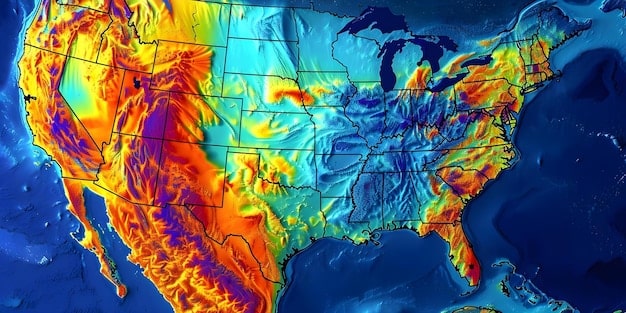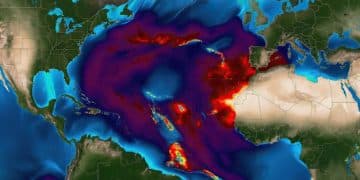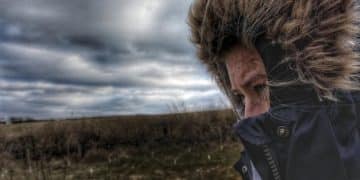Climate Change’s Impact on US Public Health by 2035: Diseases & Risks

Climate change is projected to significantly intensify public health threats in the US by 2035, accelerating the spread of vector-borne diseases and exacerbating existing health disparities through extreme weather events and air quality degradation, necessitating urgent, multifaceted adaptation strategies.
The intricate relationship between our environment and public health becomes increasingly apparent as climate patterns shift. Understanding what are the projected impacts of climate change on US public health, including the spread of vector-borne diseases, by 2035 is not merely an academic exercise; it’s a critical foresight for policymakers, healthcare professionals, and communities across the nation. The coming decade and beyond promise to reshape the health landscape, presenting both unprecedented challenges and opportunities for resilience.
Temperature Extremes and Human Health
As global temperatures continue their upward trend, the United States is poised to experience more frequent and intense heatwaves. These extreme heat events are far from a mere discomfort; they pose significant health risks, particularly for vulnerable populations. The human body struggles to regulate its internal temperature under prolonged high heat and humidity, leading to a cascade of physiological responses that can be life-threatening.
The Centers for Disease Control and Prevention (CDC) warns that heat-related illnesses, ranging from heat stroke to heat exhaustion, are among the leading causes of weather-related deaths in the US. By 2035, models suggest an increase in both the intensity and duration of heatwaves, especially in urban areas and the Southwest. This amplified heat exposure will place immense strain on public health infrastructure, requiring more robust warning systems, cooling centers, and emergency medical services.
Vulnerable Populations Under Heat Stress
Certain groups are disproportionately affected by heat extremes. Understanding these vulnerabilities is crucial for targeted interventions:
- Seniors: Older adults often have pre-existing medical conditions and may take medications that impair thermoregulation.
- Children: Young children have less developed thermoregulatory systems and are more susceptible to rapid dehydration.
- Low-income communities: These populations often lack access to air conditioning and live in urban heat islands, where concrete and asphalt absorb and re-emit heat.
- Outdoor workers: Agricultural and construction workers face prolonged exposure to high temperatures with limited relief.
Increased heat also exacerbates existing chronic conditions, such as cardiovascular disease, respiratory illnesses, and kidney disease. Hospital admissions for these conditions are expected to rise during heatwaves, further burdening healthcare systems already stretched thin. The need for proactive cooling strategies and community support networks will become paramount.
The economic implications are also substantial, with lost productivity due to heat-related illness and increased energy demands for cooling. Public health initiatives must evolve to include comprehensive heat preparedness plans that integrate urban planning, energy policy, and community outreach.
Air Quality Degradation and Respiratory Illnesses
Climate change is intimately linked to the quality of the air we breathe. Altered weather patterns, increased wildfires, and higher temperatures contribute to a worsening air pollution burden across the United States. This degradation has direct and profound impacts on respiratory health, increasing the prevalence and severity of conditions like asthma, chronic obstructive pulmonary disease (COPD), and allergic rhinitis.
Rising temperatures accelerate the formation of ground-level ozone, a potent respiratory irritant, particularly in urban and suburban areas. Longer and more intense pollen seasons, driven by warmer temperatures and elevated CO2 levels, mean increased exposure to allergens, triggering more severe and prolonged allergy and asthma attacks. By 2035, many regions in the US can anticipate a significant rise in “bad air days,” compelling more people to stay indoors and limiting outdoor activities crucial for physical and mental well-being.
Wildfires and Particulate Matter
The increasing frequency and intensity of wildfires, particularly in the Western US, represent a critical threat to air quality. Wildfire smoke is a complex mixture of harmful pollutants, including fine particulate matter (PM2.5), volatile organic compounds, and carbon monoxide. PM2.5 can penetrate deep into the lungs and even enter the bloodstream, causing a range of health issues from immediate respiratory distress to long-term cardiovascular problems and premature death.
The smoke plumes from these fires can travel hundreds or thousands of miles, affecting air quality far beyond the burn zones. This poses a challenge for public health strategies, as even communities not directly threatened by fire might experience severely unhealthy air for extended periods. Policies aimed at forest management and early wildfire detection will become increasingly important public health measures.
Moreover, the interplay between environmental factors is crucial. Drought conditions, often exacerbated by climate change, create more flammable landscapes, increasing wildfire risk. The resulting air pollution then contributes to respiratory diseases, creating a vicious cycle of environmental degradation and health impacts that will intensify over the next decade.

Vector-Borne Diseases: An Expanding Threat
One of the most concerning and rapidly evolving public health impacts of climate change in the US is the expansion of vector-borne diseases. Vectors, such as mosquitoes and ticks, are highly sensitive to environmental conditions like temperature, humidity, and precipitation. As climate change alters these factors, it creates new opportunities for vectors to thrive, expand their geographic range, and increase their capacity to transmit pathogens.
By 2035, the US is projected to see a significant northward and eastward spread of diseases like Lyme disease, West Nile virus, Zika, and Dengue fever. Warmer winters may allow ticks and mosquitoes to survive in areas where they previously could not, leading to longer transmission seasons and increased human exposure. Changes in rainfall patterns, including more frequent heavy downpours and subsequent periods of drought, can create ideal breeding grounds for mosquitoes in standing water.
Key Vector-Borne Diseases and Projections by 2035
Public health agencies are closely monitoring several diseases:
- Lyme Disease: Primarily transmitted by the black-legged tick, Lyme disease incidence has been increasing and expanding geographically. Warmer temperatures allow ticks to be active earlier in the spring and later into the fall, extending the risk period. Modeling suggests further expansion into new regions of the Midwest and Northeast.
- West Nile Virus (WNV): Carried by mosquitoes, WNV outbreaks are influenced by temperature, precipitation, and mosquito population dynamics. Warmer temperatures can accelerate the development of the virus within the mosquito and increase mosquito biting rates.
- Dengue and Zika: These mosquito-borne illnesses, once confined to tropical and subtropical regions, are appearing more frequently in the southern US. Climate change models indicate that by 2035, the range of suitable habitats for the Aedes aegypti mosquito, which transmits these viruses, could expand significantly further north, increasing the risk of local transmission.
The expansion of these diseases not only increases the number of reported cases but also places a growing burden on healthcare systems. Diagnosis and treatment can be complex, and long-term health consequences from some of these infections can be severe. Prevention strategies, including robust surveillance systems, effective vector control, and public education campaigns, will become indispensable in mitigating these expanding threats.
Furthermore, climate-driven human migration and increased travel can also facilitate the introduction and spread of emerging vector-borne pathogens, underscoring the interconnectedness of global climate and local health security.
Water and Foodborne Diseases: A Shifting Landscape
Climate change is expected to amplify the risks of water and foodborne diseases in the United States by 2035. Alterations in precipitation patterns, including more intense rainfall events and prolonged droughts, can compromise water infrastructure and safety. Heavy rainfall can overwhelm water treatment systems, leading to runoff that contaminates drinking water sources with pathogens, increasing the risk of diseases like giardiasis, cryptosporidiosis, and E. coli infections.
Conversely, during periods of drought, water scarcity can concentrate pathogens in remaining water bodies, or lead to increased reliance on unsafe water sources. Rising temperatures also contribute to the proliferation of harmful algal blooms (HABs) in freshwater and marine environments. These blooms can produce toxins harmful to humans if ingested through drinking water, contaminated seafood, or recreational contact, leading to neurological, liver, and skin issues.
Impacts on Food Safety and Supply Chains
The safety of our food supply is also vulnerable to climate impacts. Warmer temperatures can facilitate the growth of foodborne pathogens like Salmonella and Campylobacter in agricultural products and extend the survival of these pathogens during transport and storage. Changes in pest distribution and agricultural practices, driven by a changing climate, could also influence the use of pesticides and thus food safety.
Disruptions to food supply chains due to extreme weather events—such as floods destroying crops or impacting livestock—can lead to shortages and increased prices, disproportionately affecting food insecure populations. These disruptions can also force reliance on less safe food sources or drive greater demand for processed foods lacking in nutritional value.
The interplay of these factors necessitates adaptive measures in public health: investments in resilient water infrastructure, improved monitoring of food and water sources for pathogens and toxins, and enhanced surveillance of foodborne illness outbreaks. Community-level preparedness plans will also be crucial for ensuring access to safe water and food during and after extreme climate events.
Mental Health Impacts and Societal Strain
Beyond the direct physical health consequences, climate change poses a growing threat to mental health and societal well-being. By 2035, communities across the US will likely experience cumulative psychological distress from repeated exposure to climate-related events—such as wildfires, floods, hurricanes, and extreme heat. These events can lead to direct trauma, loss of homes and livelihoods, displacement, and disruption of social networks, all of which are significant risk factors for mental health conditions.
The pervasive anxiety about the future, often termed “eco-anxiety” or “climate anxiety,” is also on the rise, particularly among younger generations. This chronic stress can manifest as depression, anxiety disorders, post-traumatic stress disorder (PTSD), and even increased aggression and substance abuse. For individuals already vulnerable to mental health challenges, climate impacts can exacerbate existing conditions and undermine coping mechanisms.
Displacement and Social Disruptions
Climate migration and displacement will become more prevalent, particularly in coastal areas facing sea-level rise and regions prone to severe weather. Forced relocation can lead to profound feelings of loss, grief, and isolation, disrupting social bonds and increasing the risk of mental health crises. The stress of adapting to new environments, finding new employment, and navigating unfamiliar social systems can be overwhelming.
Climate change also threatens long-held cultural practices and traditions tied to specific ecosystems or landscapes. The loss of these connections can erode community identity and resilience, contributing to a sense of despair and helplessness. Public health strategies must integrate mental health support into disaster preparedness and response, ensuring access to counseling, community-based psychological first aid, and long-term recovery services. Addressing mental health alongside physical health is vital for building truly resilient communities in the face of climate change.
Furthermore, the economic instability and resource scarcity driven by climate impacts can fuel social unrest and conflict, adding another layer of stress on individuals and communities. Proactive policies promoting social cohesion, economic diversity, and mental health awareness are essential to mitigate these cascading societal strains.
Health Equity and Disproportionate Impacts
A critical aspect of the projected health impacts of climate change in the US by 2035 is their disproportionate burden on historically marginalized and vulnerable communities. Climate change is a “threat multiplier” for health inequities, exacerbating existing disparities based on race, socioeconomic status, age, and geography. Low-income communities, communities of color, Indigenous populations, and older adults often live in areas more susceptible to environmental hazards, have less access to resources for adaptation, and face systemic barriers to healthcare.
For example, urban heat islands disproportionately affect low-income neighborhoods, which often have less green space and more heat-absorbing infrastructure. These communities also tend to have higher rates of pre-existing chronic illnesses, making them more vulnerable to extreme heat and poor air quality. Similarly, the expansion of vector-borne diseases may disproportionately affect agricultural workers or individuals living in areas with inadequate pest control or housing.
Systemic Vulnerabilities and Barriers
Several interconnected factors contribute to these disproportionate impacts:
- Geographic exposure: Many marginalized communities live in floodplains, near industrial pollution sources, or in coastal areas vulnerable to sea-level rise and storm surge.
- Socioeconomic factors: Limited financial resources can restrict access to air conditioning, safe housing, healthy food options, and reliable transportation during climate emergencies.
- Healthcare access: These communities often face barriers to quality healthcare, including lack of insurance, transportation issues, and culturally insensitive services, limiting their ability to prevent, diagnose, and treat climate-related health conditions.
- Pre-existing health conditions: Higher rates of chronic diseases in some marginalized groups increase their susceptibility to environmental stressors.
Addressing these inequities is not just a matter of justice but also crucial for effective public health adaptation. Climate resilience strategies must be developed with an equity lens, ensuring that affected communities are at the forefront of planning and implementation. This includes investing in community-led initiatives, improving access to green infrastructure, providing culturally competent healthcare services, and enacting policies that reduce systemic barriers to health and well-being.
By 2035, the success of US public health in mitigating climate change impacts will be measured not only by overall health outcomes but also by its ability to reduce these widening health disparities and foster equitable resilience across all segments of society.

Public Health Adaptation and Mitigation Strategies
To effectively address the projected impacts of climate change on US public health by 2035, a robust combination of adaptation and mitigation strategies is essential. Adaptation focuses on preparing for and responding to the unavoidable impacts of climate change, while mitigation aims to reduce greenhouse gas emissions to prevent further warming.
On the adaptation front, public health systems must enhance surveillance and early warning systems for climate-sensitive health outcomes. This includes improving monitoring for heat-related illnesses, vector-borne diseases, and waterborne pathogens. Developing climate-resilient healthcare infrastructure—such as hospitals capable of withstanding extreme weather events and operating off-grid if necessary—is also critical. Integrating climate change into health curricula for medical professionals and public health workers will ensure a workforce equipped to handle future challenges.
Key Public Health Interventions
Strategic interventions include:
- Urban Greening: Planting trees and expanding green spaces in urban areas can combat the urban heat island effect, improve air quality, and enhance mental well-being.
- Water and Sanitation Resilience: Upgrading water treatment plants and wastewater systems to manage extreme precipitation and drought, and implementing technologies for water reuse and conservation.
- Vector Control Programs: Strengthening mosquito and tick surveillance and control efforts, including community-based approaches and responsible pesticide use, particularly in expanding endemic areas.
- Public Education and Communication: Developing targeted campaigns to inform communities about climate-related health risks, preparedness measures, and access to resources.
Mitigation efforts are equally vital. Transitioning to renewable energy sources, improving energy efficiency in buildings and transportation, and promoting sustainable land use practices can significantly reduce carbon emissions. These actions not only curb future warming but often yield immediate co-benefits for public health, such as improved air quality from reduced fossil fuel combustion. Investing in climate-smart agriculture can enhance food security and reduce emissions from the food system.
Ultimately, a collaborative, multi-sectoral approach will be necessary. This involves partnerships between public health agencies, urban planners, energy sectors, agricultural industries, emergency management, and community organizations. By integrating climate change considerations into all aspects of planning and policy, the US can build a more resilient and healthier future for its population by 2035 and beyond.
The time for action is now; proactive investment in these strategies will determine the extent to which the US can safeguard its public health against the unfolding challenges of climate change.
| Key Impact | Brief Description |
|---|---|
| 🌡️ Extreme Heat | Increased heatwaves leading to heat-related illnesses and exacerbation of chronic conditions. |
| 🦟 Disease Spread | Expansion of vector-borne diseases like Lyme, West Nile, Dengue due to altered climate. |
| 🌫️ Air Quality | Worsening air pollution from ozone and wildfires, impacting respiratory and cardiovascular health. |
| 🧠 Mental Health | Increased eco-anxiety, trauma, and psychological distress from climate events. |
Frequently Asked Questions About Climate Change and US Public Health
▼
By 2035, rising temperatures will increase the frequency and intensity of heatwaves across the US. This will lead to more heat-related illnesses such as heat stroke and exacerbation of chronic conditions like cardiovascular and respiratory diseases. Vulnerable groups, including the elderly and outdoor workers, will face heightened risks, straining emergency services and requiring more robust public health interventions for heat preparedness.
▼
By 2035, Lyme disease, West Nile virus, and potentially Dengue and Zika are projected to see significant expansion. Warmer temperatures and altered precipitation patterns are creating more favorable conditions for ticks and mosquitoes, enabling them to survive in new regions and extending their active seasons. This expansion necessitates enhanced surveillance, vector control, and public awareness campaigns.
▼
Climate change will worsen air quality by increasing ground-level ozone formation, intensifying pollen seasons, and fueling more frequent and severe wildfires. This will lead to an increase in respiratory illnesses like asthma and COPD, as well as cardiovascular problems, especially from fine particulate matter in wildfire smoke. Many regions will experience more “bad air days,” particularly affecting those with pre-existing conditions.
▼
Yes, climate change is expected to increase water and foodborne diseases. Intense rainfall can overwhelm water infrastructure, leading to contamination, while droughts can concentrate pathogens. Rising temperatures also promote harmful algal blooms. These factors elevate the risk of illnesses like E. coli, giardiasis, and toxin-related issues from seafood, necessitating improved water and food safety measures.
▼
By 2035, mental health impacts will include increased eco-anxiety, trauma from extreme weather events, and psychological distress from displacement and resource scarcity. These issues can lead to higher rates of depression, anxiety, and PTSD. Vulnerable populations will be disproportionately affected, underscoring the need for integrated mental health support in climate preparedness and disaster response strategies.
Conclusion
The projected impacts of climate change on US public health by 2035 paint a clear picture of escalating challenges, from intensifying heatwaves and worsening air quality to the expanding reach of vector-borne diseases. Yet, this foresight also offers a crucial window for proactive strategies. By investing in resilient public health infrastructure, implementing targeted adaptation measures, and committing to ambitious mitigation efforts, the United States can significantly reduce the health burden of a changing climate. Addressing these challenges effectively requires a concerted, multi-sectoral approach that prioritizes health equity and builds truly resilient communities across the nation. The health of the coming generations depends on the actions we take today.





